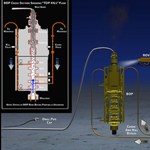Deploying Top Kill Gear

BP could deploy equipment Sunday or early next week in order to start the procedure known as a “top kill” to stem the flow of oil leaking into the Gulf of Mexico. The procedure involves shooting heavy drilling fluids into the well, followed by cement to seal it. “The earliest we think we will be able to deploy that is Sunday, or it could slip into early next week,” BP Chief Operating Officer Doug Suttles said during a teleconference. The timeframe isn’t precise because the procedure has to be done at more than 5,000 feet below water, he said.
Engineers from the U.S. Minerals Management Service, which supervises offshore oil and gas operations, are participating in the preparation for the “top kill” procedure to ensure it will be done in a safety manner, said MMS Regional Director Lars Herbst.
BP’s Suttles also said the company was siphoning 3,000 barrels of oil a day and 14 million cubic feet of natural gas a day from the leak through a mile-long tube it inserted earlier over the weekend into a shattered oil pipe on the ocean floor. On Tuesday, BP said it was collecting an estimated 2,000 barrels of oil a day from the leak.
Favorable weather also helped the company with clean-up operations on the sea surface. About 14,000 barrels of oily waters were skimmed Tuesday and four controlled burnings of oil were completed, Suttles said. Similar results are expected Wednesday as the weather continues to be favourable. “Our efforts on the surface are making a measurable difference,” Suttles said.
The well is estimated to be spewing at least 5,000 barrels of oil a day into the Gulf. The spill resulted from the April 20 explosion and sinking, two days later, of Transocean’s Deepwater Horizon drilling rig, which was finishing a well for BP. Eleven members of the crew were killed by the blast, and the spill threatens the shore of several Gulf Coast states.






